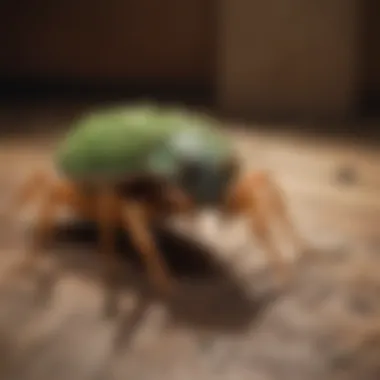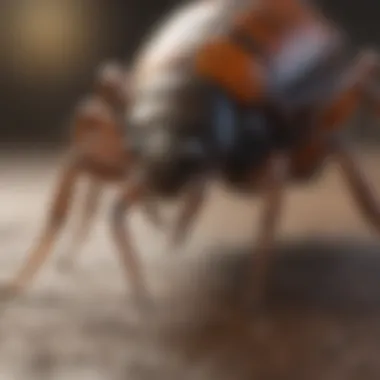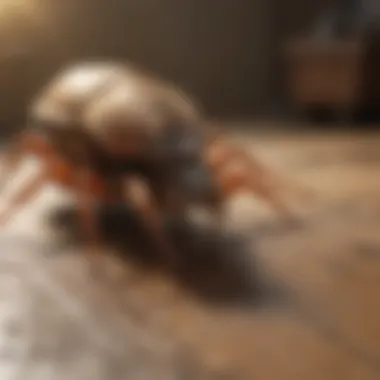Effective Ways to Eliminate Spiders and Centipedes: A Complete Guide


Preventive Pest Control Strategies
When it comes to safeguarding your home from the invasion of unwelcome critters such as spiders and centipedes, starting with preventive pest control strategies is paramount. These strategies encompass various essential elements, including house exterior protection, yard maintenance, indoor cleanliness, garbage disposal, and other innovative methods to ensure your home remains pest-free.
House Exterior Protection
In your battle against spiders and centipedes infiltrating your living space, taking measures to protect the exterior of your house is pivotal. This entails sealing cracks meticulously to thwart any potential entry points for these pesky pests. Additionally, ensuring that debris is cleared effectively around the perimeter of your home will diminish hiding spots for insects.
Yard Maintenance
Maintaining your yard is a critical component of pest control. By performing essential yard care routines regularly and implementing methods to keep your yard free of pests, you create a less hospitable environment for spiders and centipedes.
Indoor Cleanliness
Practicing meticulous indoor cleanliness is a major deterrent for spiders and centipedes seeking refuge in your home. Employing expert cleaning tips and techniques will help in maintaining a pest-resistant indoor environment, lowering the likelihood of infestations.
Garbage Disposal
Effective waste disposal methods play a vital role in pest prevention. Proper garbage disposal is not only essential for hygiene but also for deterring unwanted visitors such as spiders and centipedes from congregating in and around your home.
Other Pest Prevention Strategies
In addition to the fundamental preventive measures mentioned above, exploring innovative ways to safeguard your home further fortifies your defense against potential pest invasions, creating a more secure living environment for you and your family.
Identifying Pest Risk Areas
To combat spiders, centipedes, and other pests effectively, it's imperative to identify potential risk areas within and around your home where these critters are likely to thrive.
Moisture Prone Areas Inspection
Inspecting moisture-prone areas aids in recognizing damp conditions that are conducive to pest infestations. By implementing preventative tips, you can mitigate the risk of unwelcome guests setting up camp in these wet environments.
Crack and Crevice Inspection Guide
Conducting thorough inspections of cracks and crevices is essential in pest control. Identifying and sealing access points through these openings significantly reduces the chances of spiders and centipedes finding their way indoors.
Greenery Inspection for Pest Risks
Understanding how greenery can impact pest activity is crucial. Implementing guidelines to maintain a pest-free yard, free from overgrown vegetation that serves as a haven for pests, is essential in keeping spiders and centipedes at bay.
Additional Pest Risk Areas
Other miscellaneous areas in your home may pose a risk for pest infestations. Being aware of these potential trouble spots and taking preventive measures preemptively will help in fortifying your home against unwanted invaders.
Effective Pest Control Methods
Armed with knowledge of preventive strategies and pest risk areas, it's time to delve into effective pest control methods to address existing infestations and prevent future ones.
Natural Repellents for Pest Control
Using safe and effective natural solutions, such as essential oils, herbs, and plants, can act as potent repellents for spiders, centipedes, and other pests. These botanical options provide an eco-friendly approach to pest management.
Chemical Sprays for Pest Control


Professional-grade chemical sprays are another avenue for eradicating pests. When used judiciously and as per safety guidelines, these sprays can effectively eliminate spiders and centipedes from your living spaces.
Pest Traps: Effective Pest Control Solutions
Installing pest traps strategically can aid in capturing and removing pests like spiders and centipedes. These traps offer a humane method of pest control, allowing you to relocate them safely away from your home.
Biological Control Methods for Pest Prevention
Employing natural predators in pest management can be an environmentally friendly approach to controlling pest populations. These biological control methods offer a sustainable way to keep spiders, centipedes, and other pests in check.
Other Pest Control Methods
Innovation in pest control extends beyond traditional methods. Exploring unconventional approaches to pest management can yield effective results in combating spiders, centipedes, and other unwanted guests.
Pest Species Identification
Understanding the types of pests that may infiltrate your home is crucial for effective pest control measures.
Common Insects in Home Pest Control
Recognizing and managing insect infestations, including ants, cockroaches, and spiders, is essential for comprehensive pest control. By identifying these common pests, you can take targeted actions to eliminate them.
Identifying Rodents for Pest Prevention
Detecting and preventing rodent invasions, such as mice and rats, is vital in maintaining a pest-free home environment. Implementing strategies to deter rodents ensures your living space remains free from these vermin.
Bird Species Impacting Home Environments
Addressing issues related to problematic bird species around your home is necessary to prevent damage and health hazards. By understanding the implications of these avian visitors, you can take appropriate measures to mitigate risks.
Dealing with Wildlife on Your Property
Encounters with wildlife require a nuanced approach for effective resolution. By understanding wildlife behavior and employing suitable control measures, you can manage interactions with wildlife species safely and responsibly.
Miscellaneous Pest Species Identification
In addition to the common pests encountered in homes, lesser-known pest species may also pose a threat. Knowing how to identify and manage these uncommon pests equips you with the knowledge to tackle diverse pest challenges effectively.
DIY Pest Control Techniques
Equipping yourself with do-it-yourself pest control techniques empowers you to address pest issues promptly and effectively.
Homemade Pest Control Solutions
Embracing eco-friendly homemade pest control remedies allows you to combat pests using simple yet effective DIY methods. These solutions offer a natural and cost-effective approach to pest management.
Using Essential Oils for Pest Control
Utilizing essential oils as natural repellents can deter pests like spiders and centipedes from infesting your home. Creating a bug-free environment with the aromatic properties of essential oils is a sustainable way to protect your living space.
Effective Pest Traps and Barriers
Implementing pest traps and barriers efficiently contributes to pest control efforts by capturing and deterring unwanted intruders. These mechanisms offer a proactive approach to controlling pest populations within your home.
Top Reputable Pest Control Brands


When seeking pest control products, opting for trusted brands ensures quality and efficacy in managing pest infestations. Safeguard your home with reliable solutions from reputable brands to maintain a pest-free environment.
Miscellaneous DIY Pest Control Techniques
Explore unique do-it-yourself solutions for various pest issues at home. By employing creative strategies tailored to specific pest challenges, you can navigate pest control effectively and protect your home from undesirable invaders.
Understanding Spiders and Centipedes
In a home environment, understanding the behavior and characteristics of spiders and centipedes is crucial for effective pest management. Spiders, with their eight legs and ability to produce silk, are arachnids that prey on insects, helping control other pests in your home. On the other hand, centipedes, with their numerous legs and carnivorous diet, also contribute to the ecological balance indoors. By comprehending the nuances of these creatures, homeowners can better implement targeted elimination strategies, leading to a more harmonious living space.
Overview of Spiders
Common types of spiders
Delving into the realm of common spider species found in households sheds light on the diversity of these arachnids. From the elegant Orb-weaver spiders to the elusive Cellar spiders, each type brings a unique set of characteristics. Understanding the varying behaviors and habits of these spiders aids in both identification and effective elimination methods. Recognizing the key traits of common spiders enables homeowners to tailor their approach, ensuring a specific and successful pest control strategy.
Identification of spider infestations
Identification of spider infestations involves astute observation of web patterns, egg sacs, and spider anatomy. Recognizing signs such as webs in corners, egg sacs in dark areas, and actual sightings of spiders are pivotal in confirming an infestation. By pinpointing these indicators early on, homeowners can swiftly address the issue, preventing further proliferation. The ability to identify spider infestations promptly is paramount in implementing timely and efficient eradication techniques.
Insight into Centipedes
Characteristics of centipedes
Exploring the unique characteristics of centipedes unveils their role in the household ecosystem. With their segmented bodies and rapid movements, centipedes serve as natural predators to smaller insects. Their nocturnal nature and preference for damp environments distinguish them from spiders, necessitating specific elimination approaches. Understanding the distinctive traits of centipedes equips homeowners with the knowledge needed to target their removal effectively.
Signs of centipede presence
Detecting the presence of centipedes involves noticing their shed exoskeletons, swift movements, and preference for dark hiding spots. These discernible signs indicate a possible centipede infestation, urging immediate action. By identifying these indicators promptly, residents can prevent centipedes from establishing a strong foothold, maintaining a pest-free living environment. Recognizing the signs of centipedes paves the way for strategic pest control measures.
Prevention Measures
It is essential to prioritize prevention measures when dealing with spider and centipede infestations in your home. By implementing proactive strategies, you can effectively deter these pests from entering your living space. One crucial element of prevention measures is maintaining cleanliness. Regular cleaning routines play a significant role in creating an environment that is less hospitable to spiders and centipedes. By consistently cleaning and removing potential hiding spots for these pests, you can reduce the likelihood of infestations taking root. Additionally, clutter reduction strategies are key in minimizing the spaces where spiders and centipedes can thrive. By decluttering your home and removing objects that provide harborage for pests, you can limit their presence and make it more challenging for them to establish themselves.
Maintaining Cleanliness
Regular cleaning routines
Regular cleaning routines are fundamental in the fight against spiders and centipedes. By regularly dusting, sweeping, and vacuuming your home, you can eliminate the debris and dust that attract these pests. The key characteristic of regular cleaning lies in its consistency; the more frequent and thorough your cleaning efforts, the less likely pests are to find a welcoming environment. The advantage of incorporating regular cleaning into your routine is its proactive nature, preventing infestations before they become a problem. While this approach requires dedication and diligence, the long-term benefits of a pest-free home make it a worthwhile endeavor.
Clutter reduction strategies
Clutter reduction strategies are indispensable for discouraging spiders and centipedes from nesting in your home. By organizing and decluttering your living spaces, you eliminate the hiding spots and nesting sites that these pests favor. The key characteristic of clutter reduction lies in its ability to transform chaotic areas into clean, open spaces that are less appealing to pests. One unique feature of clutter reduction strategies is their dual impact on both aesthetics and pest control. By maintaining a clutter-free environment, you not only enhance the visual appeal of your home but also create an inhospitable habitat for spiders and centipedes. While implementing clutter reduction strategies may require time and effort, the benefits of a tidy, pest-resistant home make it a worthwhile investment.
Sealing Entry Points
Identifying and sealing cracks
Identifying and sealing cracks in your home is a critical step in preventing spiders and centipedes from entering. Cracks in walls, floors, and foundations serve as entry points for pests, allowing them easy access to your living spaces. The key characteristic of addressing cracks is the precision required to identify even the smallest openings that pests can exploit. By sealing these cracks with caulk or sealant, you block off potential entryways and create a barrier against infestations. One unique feature of this method is its effectiveness in closing off hidden entry points that may go unnoticed. While the process of identifying and sealing cracks demands attention to detail and thoroughness, the peace of mind that comes from securing your home against pests is invaluable.
Installing door sweeps
Installing door sweeps is a proactive measure to prevent spiders and centipedes from slipping in through gaps beneath exterior doors. Door sweeps act as a physical barrier, blocking pests from entering your home through this common entry point. The key characteristic of door sweeps is their simplicity and ease of installation, making them a practical choice for homeowners seeking to reinforce their pest control efforts. One unique feature of door sweeps is their versatility, as they can be fitted to various door types and sizes. While installing door sweeps requires minimal time and tools, the protection they offer against intruding pests is substantial. By incorporating door sweeps into your pest prevention strategy, you add an extra layer of defense to safeguard your living space from unwanted creepy crawlers.


Natural Remedies
Natural remedies play a significant role in addressing pest issues like spiders and centipedes in one's home. These remedies offer a safe and environmentally friendly alternative to chemical pesticides, promoting a healthier living environment for you and your family. When considering natural remedies, it is essential to understand their non-toxic nature and sustainable impact on pest control methods. By incorporating natural remedies into your pest management strategy, you contribute to a greener and more eco-conscious approach to handling unwanted intruders.
Essential Oils
Lavender oil
Lavender oil stands out as a popular choice when dealing with spiders and centipedes due to its versatile properties. It not only acts as a potent repellent but also emits a pleasant aroma, functioning as a dual-purpose solution in combating these pests. The calming and soothing characteristics of lavender oil make it a desirable option for creating a relaxing atmosphere while warding off unwanted insects. However, it is important to note that lavender oil's effectiveness may vary based on the concentration and application method used.
Peppermint oil
Peppermint oil is another effective natural remedy known for its strong scent that deters spiders and centipedes from infesting your home. Its powerful odor disrupts the insects' sensory receptors, making it difficult for them to navigate and thrive in the treated areas. Peppermint oil's refreshing scent makes it a popular choice for those seeking a practical and aromatic solution to pest control. While peppermint oil serves as a useful repellent, some individuals may find its scent overpowering, thus requiring moderation in application to maintain a balanced indoor ambiance.
Vinegar Solution
Preparation and application
The vinegar solution offers a multifaceted approach to combating spiders and centipedes in your home. Its acidic nature serves as a natural deterrent, creating an inhospitable environment for pests. By preparing a vinegar solution and applying it to targeted areas, you create a barrier that repels insects while effectively disinfecting surfaces. The simplicity and affordability of this remedy make it a practical choice for individuals looking to address pest issues without the use of harsh chemicals. However, it is important to note that vinegar's strong odor may linger for some time, requiring proper ventilation to maintain indoor air quality.
Professional Pest Control
Professional pest control is a vital aspect in the battle against spiders and centipedes infestation in your home. Retaining the services of skilled pest control professionals ensures a thorough and effective eradication of these unwelcome guests. Unlike DIY methods, professional pest control companies possess specialized knowledge and equipment to tackle infestations efficiently. By entrusting the task to experts, you can rest assured that your home will be free from spiders and centipedes, promoting a safe and hygienic environment for your family.
When considering professional intervention, it is essential to acknowledge the multiple benefits it offers. One key advantage is the in-depth expertise that pest control services bring to the table. These professionals have a deep understanding of pest behaviors and elimination strategies, allowing them to target the root cause of the infestation effectively. Furthermore, professional pest control ensures a more sustainable solution compared to temporary DIY methods, providing long-term relief from spiders and centipedes in your home.
Choosing the right pest control company is a crucial decision that can significantly impact the effectiveness of the treatment. It is imperative to select a reputable and experienced company with a proven track record in handling spider and centipede infestations. Look for companies that employ certified technicians and use eco-friendly pest control products to safeguard your family and pets. Additionally, consider getting multiple quotes and comparing services to find a company that aligns with your budget and requirements.
Consulting Pest Control Services
Benefits of Professional Intervention
Engaging professional pest control services offers a multitude of benefits that contribute to the overall goal of eliminating spiders and centipedes from your home. The primary advantage lies in the expertise and experience these professionals bring, ensuring a comprehensive and targeted approach to pest eradication. Moreover, professional intervention guarantees a higher success rate in eliminating infestations, providing a more effective and lasting solution for your home.
Choosing the Right Pest Control Company
Selecting the appropriate pest control company is a critical step in ensuring the success of the treatment process. An essential aspect to consider is the company's reputation and history of successful pest eradication. Opt for a company that prioritizes customer satisfaction and offers tailored solutions to address your specific pest control needs. By choosing a reliable and proficient pest control company, you can have peace of mind knowing that your home is in safe hands.
Home Remedies
Home remedies play a crucial role in this comprehensive guide on eliminating spiders and centipedes from your living space. By utilizing natural solutions for pest control, you can create a healthier environment without harmful chemicals. Home remedies offer a cost-effective and eco-friendly approach to managing infestations, catering to individuals seeking safer alternatives for pest eradication. Embracing home remedies empowers homeowners to take control of their living conditions proactively.
DIY Traps
Creating homemade spider traps
Creating homemade spider traps serves as a fundamental aspect of the overall strategy to combat spider infestations effectively. These traps, typically designed using simple household items, aim to catch spiders without posing risks to household members or pets. The key characteristic of homemade traps lies in their accessibility and ease of setup, making them a popular choice among individuals wary of using commercial pest control products. Despite their simplicity, homemade spider traps prove highly efficient in reducing spider populations, offering a non-toxic solution for managing arachnid intrusions.
Effective centipede removal methods
When addressing centipede infestations, the implementation of effective centipede removal methods is vital to achieving a pest-free environment. These methods focus on eliminating centipedes without exposing residents to harmful chemicals commonly found in commercial pesticides. A key characteristic of these removal techniques is their natural composition, minimizing environmental impact while effectively targeting centipede populations. While homemade solutions may require more frequent application compared to chemical sprays, their non-toxic nature aligns with the eco-conscious approach advocated in this article.
Natural Repellents
Cedar chips
The introduction of cedar chips into your pest control regimen contributes significantly to warding off spiders and centipedes. Cedar's natural oils act as a potent deterrent for arachnids and centipedes, providing a sustainable and aromatic solution for pest management. The key characteristic of cedar lies in its long-lasting fragrance, which not only repels pests but also adds a pleasant scent to your home. While cedar chips offer a powerful repellent effect, their main disadvantage lies in requiring periodic replacement to maintain effectiveness.
Citrus peel solutions
Utilizing citrus peel solutions as natural repellents presents a refreshing approach to pest control within the home environment. The high citric acid content in citrus peels acts as a deterrent for spiders and centipedes, deterring them from entering your living space. The key characteristic of citrus peel solutions is their versatility, allowing homeowners to repurpose kitchen waste for effective pest management. Despite their efficacy, citrus peel solutions may necessitate frequent application to uphold repellent qualities, requiring consistent effort in maintaining a pest-free home.



